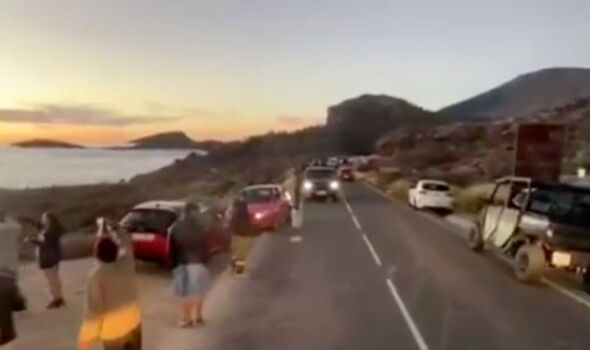World
Mass Tourism Crisis Hits Tenerife’s Teide National Park

Environmentalists have raised urgent concerns regarding the impact of mass tourism at Teide National Park in Tenerife. Recent video footage shared on social media revealed severe traffic congestion, overcrowding, and instances of inappropriate behaviour among visitors. The alarming scenes included vehicles parked haphazardly, individuals urinating in public areas, and tourists posing dangerously in the road for photographs.
These chaotic conditions were reminiscent of the disruptions witnessed on August 15, a public holiday in Spain, which prompted a strong response from the Tenerife Association of Friends of Nature (ATAN). In a video posted online, the group condemned the ongoing turmoil caused by the influx of tourists and called for immediate action from local authorities. According to Canarian Weekly, ATAN warned that if the current situation persists, “Teide will become nothing more than a theme park.”
The concerns echo statements made earlier this year by Cabildo President Rosa Dávila, who highlighted the need to treat Teide as a “natural sanctuary that deserves respect and protection.” Despite her assertions, ATAN contends that the reality on the ground contradicts her words, with the delicate ecosystem facing increasing pressure from the growing number of visitors.
Reports indicate that off-road safari companies have been arriving in convoys of up to a dozen vehicles, while groups of motorbikes and quad bikes have been seen racing through the park. This activity has raised alarms about the disturbance of the tranquility that the area is meant to preserve.
In response to the escalating issues, the Cabildo of Tenerife has announced plans to restrict private vehicle access to the national park. Under the new regulations, access will be limited to buses and coaches during specified times. José Miguel Ruano of the Tenerife Cabildo clarified that this is “not a total ban on private vehicles.” He elaborated that there will be designated time slots for bus transit, ensuring a more organized flow of visitors.
The upcoming changes form part of the new Master Plan for Use and Management, which is currently being finalized by local officials. This plan not only aims to regulate visitor numbers but also seeks to protect traditional activities, such as beekeeping, while enhancing access for cyclists.
Environmental groups and local authorities continue to grapple with the balance between promoting tourism and safeguarding the natural beauty of Teide National Park. As the situation evolves, many are hopeful that the planned regulations will mitigate the impacts of mass tourism and preserve the area for future generations.
-

 Entertainment3 months ago
Entertainment3 months agoAnn Ming Reflects on ITV’s ‘I Fought the Law’ Drama
-

 Entertainment4 months ago
Entertainment4 months agoKate Garraway Sells £2 Million Home Amid Financial Struggles
-

 Health3 months ago
Health3 months agoKatie Price Faces New Health Concerns After Cancer Symptoms Resurface
-

 Entertainment3 months ago
Entertainment3 months agoCoronation Street’s Carl Webster Faces Trouble with New Affairs
-

 Entertainment3 months ago
Entertainment3 months agoWhere is Tinder Swindler Simon Leviev? Latest Updates Revealed
-

 Entertainment4 months ago
Entertainment4 months agoMarkiplier Addresses AI Controversy During Livestream Response
-

 Science1 month ago
Science1 month agoBrian Cox Addresses Claims of Alien Probe in 3I/ATLAS Discovery
-

 World2 weeks ago
World2 weeks agoBailey Announces Heartbreaking Split from Rebecca After Reunion
-

 Health4 months ago
Health4 months agoCarol Vorderman Reflects on Health Scare and Family Support
-

 Entertainment4 months ago
Entertainment4 months agoKim Cattrall Posts Cryptic Message After HBO’s Sequel Cancellation
-

 Entertainment3 months ago
Entertainment3 months agoOlivia Attwood Opens Up About Fallout with Former Best Friend
-

 Entertainment2 weeks ago
Entertainment2 weeks agoCoronation Street Fans React as Todd Faces Heartbreaking Choice





















